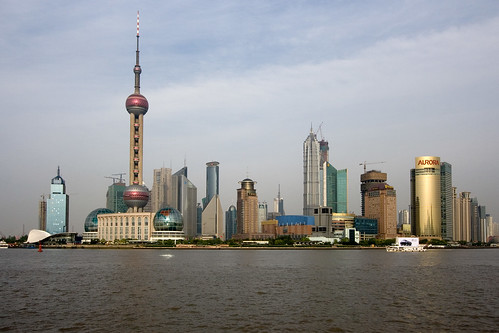 |
| Shanghai Skyline from http://www.flickr.com/photos/keithmarshall/474369474/ |
Visiting Shanghai in China is a bit like visiting a chameleon! It’s constantly changing, constantly different. I’ve been to Shanghai quite a few times over the last 10 years and every time I’ve visited, it’s been like almost visiting a different city. The pace of change is slowing, but this vibrant city is constantly reinventing and changing.
The first time I ever went was in the early 1990s, and at that time the thing that struck me was that the whole city was erupting with buildings. It was reported that there was something like 50‑60% of all the building cranes in the world in Shanghai at that time. Later I think they probably were uprooted and moved on to Dubai, which went through a similar building boom before the financial crisis.
As every time I have gone there it has felt like it is the same but also a different city, it makes me think of a “chameleon”. Changing and adapting to the environment and the world around it.
The good news is that although buildings were erupting everywhere, I was still struck by the beauty of most of the new buildings. One of the things that often happens when cities grow fast is that the beauty of buildings seems to be ignored for speed to throw up buildings. Whereas in Shanghai there is a lot of very stunning architecture and very appealing buildings, many of which emerge even more at night. Most seem to be lit up or have special effects in light happening on them which creates an entertaining view.
Unfortunately there was one problem through all this change and drive to build a modern city. For a long time they just bulldozed away the history of the city. They just knocked everything down. So a lot of historic buildings and old styles were just bulldozed away. In recent years the impact of what was happening was appreciated and there has been a more sympathetic approach to try and maintain some of the heritage as well.
This is important as the history of Shanghai is quite unusual – and surprising -with it being heavily dominated by foreign influences and styles. Right back in the mid‑1800s, part of the city was effectively part of Britain who had a concession over part of the city. As did the USA who also had a concession for part of the city. While the French also controlled another part of the city. This created a divided city with different administrations by the French, by the Americans, by the British. They had their own courts, their own systems and their own armed forces – and different styles and influences.
In the late 1920s, the army captured Shanghai and ran part of it. And then the Japanese invaded it. So a very complicated past!
It wasn’t until after the Second World War that the United States, Britain and France renounced their claims and so it became again part of China, in its entirety. Eventually, in 1949, it fell under the communist forces. But during that whole time, it prospered as it was declared a special development zone, and has been a focus for investment and innovation. So there was a very eclectic and unusual heritage and history, with a lot of it bulldozed. One exception is probably the French sector, which has some amazing art‑deco style bars and buildings that still exist.
Shanghai now has two airports. Pudong, which is now the international airport, and Hongqiao. The newer Pudong airport is relatively far out of the city, and it takes quite a while to get in. The thing that strikes you as you drive into town is, it feels a little bit misty.
What you realize is that this is smog. The pollution is pretty bad in Shanghai. Although there is more awareness of the need to control the emissions from the massive industrial growth, it can be fairly bad. I’ve never really seen crystal blue clear skies. Visitors who suffer from asthma or breathing issues s, sometimes find it, particularly in the very hot summers, more difficult to breathe.
Another change over the years has been that early visitors as China opened up to visitors was the vast amount of bicycles. There is still a lot, but car ownership and usage has exploded and there is a very sophisticated road system to match. In the centre of the city it’s actually built up quite high, and almost above the city. But of course, it has still has traffic problems as the growth of the city and traffic moves even faster than development can keep up.
One observation which surprised me was how much English there was on the road system. Most of the road signs had English and even the advertising billboards have English on them. So actually, even as a foreigner speaking English, it’s surprising how much you understand that’s really going on. And in Shanghai, particularly, in the tourist areas, English is pretty widely spoken.
One key thing to remember about China is that in spite of all of this growth and energy and it being a very modern city, it does of course have fairly strict legislation and the state has a very conservative approach, and there is a lot of censorship, control and so on. It is important to understand and act accordingly.
But it is easy to forget it often when you’re in Shanghai, just because it seems so modern and contemporary. It is easy to forget there are many areas of life that has strong government restrictions and approaches. For example, the one‑child rule still exists in China, where couples are only allowed to have one child. That does lead to a whole different mindset about life and living.
I also felt that, unlike other parts of Asia, the approach to service is different and less effusive. It’s not that people are unfriendly, it’s just not as service‑orientated as the rest of Asia. People are more pushy and you will find people pushing and shoving, and getting into your “personal space”. This is just a cultural thing, and something you just need to get used to.
You so see a very exciting and dynamic culture emerging by observing the younger generation. They are trendy and embrace change and technology with vigour. This is a generation living though a period of huge change and massive opportunities, and are happy to embrace new ideas and technology. There is a real sense of excitement and opportunity amount this generation.
The city now has the most amazing spread of restaurants and food, amazing shops with beautiful new shopping centers with incredible, stunning decor.
Shanghai is a very exciting place. I really, really like Shanghai. It has a population of about 17 million people. There’s over 350 hotels, with 60,000 hotel rooms. It is really geared up for tourists and for tourism. And there’s is a lot of things to do!
So here are my tips for travellers visiting Shanghai.
Getting and Going there:
Visa: One of the things you need to ensure is that you have a visa! This takes time to get, and so you have to ensure you apply plenty of time before. If you are going to visit there a couple of times, it is best to apply up-front for a multiple‑entry visa. Without a visa obtained in advance, you will not get into the country – as a colleague of mine discovered. As they had no visa, they were frog‑marched across to the airline offices, forced to buy a new ticket, and had to leave on the next flight home. Although, in their case they actually flew via Hong Kong and sorted out a visa from there.
Illness: The other thing that’s very important, that is a hangover from SARS scare some years back, is to make sure that you don’t go when you’re ill with a fever or a cold. There is a scanner you pass through on arrival and if they read a temperature you are unlikely to get into the country.
Packing: As you pack, remember that the Chinese government is very conservative, and make sure you leave out about if there’s anything that is likely to cause offense, or be an issue (like some books and materials)
Deciding where to stay:
As with any travel, be careful where you stay. Not because Shanghai is dangerous, but it is a vast sprawling city and so on a first trip try and stay more central and accessible. I recommend you stay close to the Bund area. Not only is it central, but it is also a very pretty part of town. It’s within walking distance, of the river and other great areas to explore, that I will cover in more detail below.
Sightseeing:
Private tours: On any first visit to Shanghai, I recommend you arrange to go a private tour, rather than, finding your way around. Because although there is transport, and an underground, it can be a very confusing and fraught with challenges. These private tours can be arranged through the concierge at your hotel. It’s going to cost you only about 50 US Dollars a day per person – and that includes travelling in an air conditioned van, with both a driver and a guide. Of course they will take you to tourist trap places like the inevitable pearl factories where they will be getting kickbacks. But you will find you going to get that on most tours, even organized tours. The Luxury Travel blog recommends, for example, a firm called At your Side.
A guided tour is really important on a first trip, especially if time is tight. There is such an ncredibly fascinating and rich history. It is also a fairly complex history, and the guides will explain it and ensure you see all the range of aspects of the varied life and heritage in the city.
City Guides: But, If you don’t want to do that, there is another good option that the Shanghai Municipal Tourism Administrative Commission has developed. They have created a series of Shanghai City tour guide series which are fantastic. You’ll find these in all of the hotels. They are themed based on interests, such as “Historical, and Contemporary Scenic Spots“, “Shanghai, a Paradise for Shoppers“, “The Shanghai Science and Publicity tours, an Amazing World of Science and Technology“, “The Dazzling World of Entertainments at Night“, “Tourist Attractions New and Exciting,” and even “Tour of Shanghai Old Movies” because it used to be a popular movie making city. There are some more unusual ones with a political spin like the “Tour of Shanghai Happy Farmers Life” going back to nature, and enjoying poetic Pastoral delight. Living in a farmer’s house, having a farmer’s meal, working as a farmer and enjoying a happy farmer’s life.
The series is based on what they call “The Seven Wonders of the World, Seven Days in Shanghai” So you could actually spend seven days on each of these, so they’re really interesting.
Self touring: But if neither the private tour nor the suggested tours in the leaflets appeal, here are the things I would recommend you see:
The Bund Area. This is an area that would be called a key historical and contemporary scenic spot. It’s basically on the riverside, and runs from the Waibadu bridge to Jinling East Road. On the east side of the Bund, is the Huangpu River Sightseeing Embankment which you can stroll along. On the Western side, are a long stretch of Western style old buildings which is known as the World Architectural Gallery. These are just amazing buildings, from the 1920s and 1930s. Very beautiful buildings, nicely scrubbed up and just amazing pictures. On the my photos below and in a linked gallery I’ve got some of these to show just how fabulous they are.
At night, they’re all lit up with colorful lights and it does look absolutely amazing, and gets very vibrant, and buzzing down there. It’s very safe, although there will be a lot of hawkers selling you fake bags and that sort of stuff, as there is a visible police presence and they ensure things are calm and hassle free.
On the river there’s a huge amount of commercial traffic but also loads of tourist boats all brightly lit up. It’s very exciting and vibrant, lovely to walk along and enjoy.
On the Bund you can see across the river to a couple of important landmarks which are worth visiting as well. One of which is the Oriental Pearl Tower. This is reported to be the tallest TV tower in Asia, and the third highest in the world. It has 11 spheres of varying sizes at various heights. There is an observation deck, from where you get the most amazing views of the city. There’s the inevitable revolving restaurant at the top too.
Also on this side of the river, is the Jin Mao Tower. The Jin Mao Tower is really one of the most symbolic buildings of modern Shanghai. It’s the tallest building in the whole of China, and the third tallest building in the world, with an observation deck on the 88th floor. It’s the highest point in China that you can do sightseeing. It can actually hold an unbelievable 1,000 visitors at a time. You are whisked up by a very fast elevator that takes about 45 seconds to get to the top.
There are a couple of new museums, which are worth doing. The Shanghai Museum is especially worth visiting. It’s located in the south of People’s Square. And it has the most remarkable display and review of China’s art. It is also an amazing round building. It has six areas, 12 exhibition halls with bronzes, pottery, porcelain sculpture, calligraphy, painting, jade ware, coins, furniture. It really is just incredible. And that’s quite near the Bund area, but it’s relatively easy to get to on the metro. And you can read more about that at Shanghaimuseum.net.
There are couple of quirky things that you may want to go and do. There is a rather unusual sightseeing tunnel near the Bunt that runs from the Bunt and to the Pearl Tower. So you can actually go from one side to the other underneath the river. It’s a pretty big tunnel, and the interior of the wall has got all these bizarre colors of starfish and blossoms and high‑tech lighting and a very loud acoustic system. It reminds me a little bit of the Freemont Experience in the old part of Las Vegas.
They also havean indoor skiing resort, which is a little bit sort of out of town. Again it is a very large indoor skiing resort.
At night, it is worth doing one of the night cruises on the river, because everything’s lit up in Shanghai, and ait is quite a feast to view the city at night from the river.
In terms of shopping, there are a couple of major shopping areas. There’s the Xujiahui commercial area which has a square at the center, with piles of shopping centers: the Oriental, the Pacific Grand Gateway, the Hui Jin Department Store, etc. But probably the one which is the one that the tourists go to is the Yuyuan Garden Commercial City.
So that’s what I’ve got on Shanghai. It’s a very exciting city. It’s constantly changing. And it’s just partly the whole thing is just being there and soaking it all up and just enjoying it.
For more recommendations on things to do: TripAdvisor Things to Do and the Official Shanghai Visitor Site
Got any tips of your own? PLease add them in the comments section!
Subscribe for email updates of new postings. Follow Tips for Travellers on Twitter. Join the Tips for Travellers Facebook page.
 |
| Add caption |
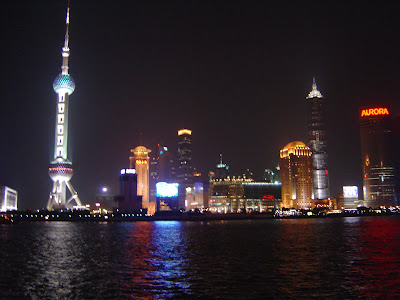 |
| Shanghai skyline at night – looking across from The Bund |
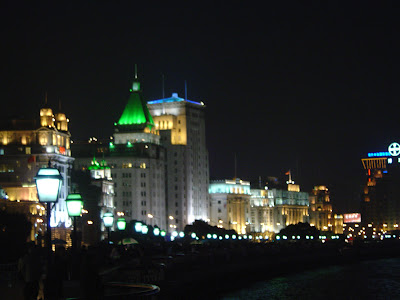 |
| The Bund (Shanghai China)and some of the buildings known as the World Architectural Gallery |
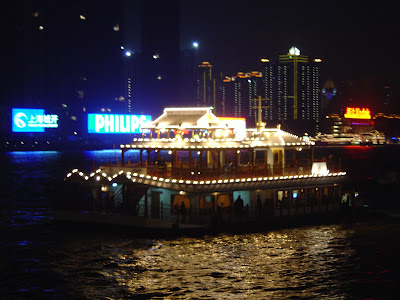 |
| Tourist boat on the river at The Bund Shanghai China |
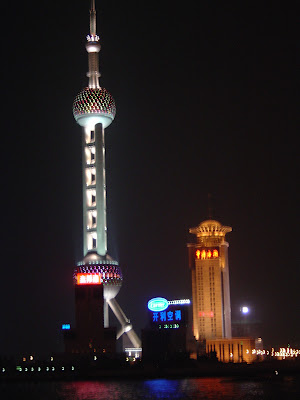 |
| Oriental Pearl Tower Shanghai China |
Related












